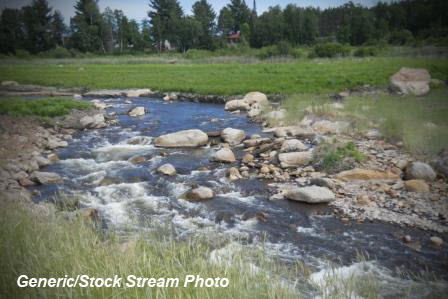
6.18 Miles
3.25 - 9.43
Cool-Cold Headwater, Cool-Warm Headwater
2015
Good
Ashland
Yes
No
No
Fish and Aquatic Life
Overview
Trout Brook flows north from the outlet of English Lake and into the Brunsweiler River on the Bad River Indian Reservation, just before the Brunsweiler's confluence with the Marengo. This stream supports a population of brook, brown and rainbow trout. Several small feeders also support trout. A granite quarry beside the stream near English Lake caused a small impounded area behind granite debris. Downstream springs help maintain the cold water necessary for trout. Water level fluctuations can be problematic. The upstream reaches are primarily in upland hardwood, while the lower half of the stream is mostly pastured. A licensed private fish hatchery pond has operated on a small feeder stream. Beaver may be a problem in some areas.
During survey work conducted as part of the coastal wetlands evaluation one rare species of macroinvertebrate was found and overall taxa richness was moderate (5-24 species) (Epstein 1997). Cropland was a potential pollutant source at the survey site.
Date 1999
Author Aquatic Biologist
Impaired Waters
Trout Brook was segmented from two into three pieces during the 2022 cycle in order to define the portion on Tribal Lands. Trout Brook from its mouth to near Old County Road was listed in 2016 for fecal coliform causing recreational restrictions. In the 2022 cycle the first 0.6 miles were delisted, as this is on tribal lands and outside of WI DNR jurisdiction. Evaluations in the 2016 and 2020 cycles showed no impairment due to biology or temperature.
Date 2022
Author Ashley Beranek
Condition
Wisconsin has over 84,000 miles of streams, 15,000 lakes and milllions of acres of wetlands. Assessing the condition of this vast amount of water is challenging. The state's water monitoring program uses a media-based, cross-program approach to analyze water condition. An updated monitoring strategy (2015-2020) is now available. Compliance with Clean Water Act fishable, swimmable standards are located in the Executive Summary of Water Condition in 2018. See also the 'monitoring and projects' tab.
Reports
Recommendations
Monitor Fish Community
AU 17722, poor fIBI, Station 10022075
Management Goals
Wisconsin's Water Quality Standards provide qualitative and quantitative goals for waters that are protective of Fishable, Swimmable conditions [Learn more]. Waters that do not meet water quality standards are considered impaired and restoration actions are planned and carried out until the water is once again fishable and swimmable
Management goals can include creation or implementation of a Total Maximum Daily Load analysis, a Nine Key Element Plan, or other restoration work, education and outreach and more. If specific recommendations exist for this water, they will be displayed below online.
Monitoring
Monitoring the condition of a river, stream, or lake includes gathering physical, chemical, biological, and habitat data. Comprehensive studies often gather all these parameters in great detail, while lighter assessment events will involve sampling physical, chemical and biological data such as macroinvertebrates. Aquatic macroinvertebrates and fish communities integrate watershed or catchment condition, providing great insight into overall ecosystem health. Chemical and habitat parameters tell researchers more about human induced problems including contaminated runoff, point source dischargers, or habitat issues that foster or limit the potential of aquatic communities to thrive in a given area. Wisconsin's Water Monitoring Strategy was recenty updated.
Grants and Management Projects
Monitoring Projects
| WBIC | Official Waterbody Name | Station ID | Station Name | Earliest Fieldwork Date | Latest Fieldwork Date | View Station | View Data |
|---|
| 2913900 | Trout Brook | 10022075 | Trout Brook-Spring Brook Road | 1/1/2015 | 1/1/2015 | Map | Data |
| 2913900 | Trout Brook | 10022074 | Trout Brook at Quarry Rd | 6/5/2013 | 1/1/2015 | Map | Data |
|

Watershed Characteristics
Trout Brook is located in the Marengo River watershed which is 217.53 mi². Land use in the watershed is primarily forest (67.40%), wetland (15.30%) and a mix of grassland (11.60%) and other uses (5.70%). This watershed has 450.89 stream miles, 1,497.18 lake acres and 18,112.32 wetland acres.
Nonpoint Source Characteristics
This watershed is ranked Medium for runoff impacts on streams, Not Available for runoff impacts on lakes and Low for runoff impacts on groundwater and therefore has an overall rank of Low. This value can be used in ranking the watershed or individual waterbodies for grant funding under state and county programs.However, all waters are affected by diffuse pollutant sources regardless of initial water quality. Applications for specific runoff projects under state or county grant programs may be pursued. For more information, go to surface water program grants.
Trout Brook is considered a Cool-Cold Headwater, Cool-Warm Headwater under the state's Natural Community Determinations.
Natural communities (stream and lake natural communities) represent model results and DNR staff valiation processes that confirm or update predicted conditions based on flow and temperature modeling from historic and current landscape features and related variables. Predicated flow and temperatures for waters are associated predicated fish assemblages (communities). Biologists evaluate the model results against current survey data to determine if the modeled results are corect and whether biological indicators show water quaity degradation. This analysis is a core component of the state's resource management framework. Wisconsin's Riverine Natural Communities.
Cool (Warm-Transition) Headwaters are small, sometimes intermittent streams with cool to warm summer temperatures. Coldwater fishes are uncommon to absent, transitional fishes are abundant to common, and warm water fishes are common to uncommon. Headwater species are abundant to common, mainstem species are common to absent, and river species are absent.
Cool (Cold-Transition) Headwaters are small, usually perennial streams with cold to cool summer temperatures. Coldwater fishes are common to uncommon (<10 per 100 m), transitional fishes are abundant to common, and warm water fishes are uncommon to absent. Headwater species are abundant to common, mainstem species are common to absent, and river species are absent.